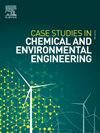Ag and Al2O3/water two-phase transient flow analysis in a double-pipe heat exchanger equipped with baffles and rotating inner tube
Q1 Environmental Science
Case Studies in Chemical and Environmental Engineering
Pub Date : 2025-01-27
DOI:10.1016/j.cscee.2025.101117
引用次数: 0
Abstract
Considering the wide application of double-pipe heat exchanger made their performance improvement very important. Employing aqueous nanofluid (NF) of Ag and Al2O3 as the working fluid inside the inner tube of the heat exchanger and its rotation as the respective passive and active enhancing methods are investigated numerically using the two-phase mixture method. The sensitivity analysis was performed to reveal the effect of Reynolds (Re) number, NF concentration and tube rotational speeds on heat transfer coefficient, heat transfer effectiveness, and efficiency ratio. The Re number, NF concentration, and rotation speed lie in 1000-3000, 0–4 %, and 300–500 rpm, respectively. The results show the higher improving effect of Ag rather than Al2O3 nanoparticle; for Re = 1000, 1500 and 2000 the efficiency ratio averaged between different concentrations are 39 %, 30 %, 20 % for Al2O3/water and 62 %, 65 % and 26 % for Ag/water NFs, respectively. By increasing the Re number, the enhancing effect of velocity increment on heat transfer rate prevails and hinders that of employing NF. Also, in rotating mode, the enhancement made by increasing the Re number is higher in the rotation speed of 500 rather than 300 rpm. The overall change of efficiency ratio versus the Re number increment is decreasing and the greatest improving effect of using NF is for the lowest Re numbers. Also, the enhancement due to increasing the Re number increment is higher at a rotational speed of 500 rather than 300 rpm.
带有折流板和旋转内管的双管换热器中Ag和Al2O3/水两相瞬态流动分析
考虑到双管换热器的广泛应用,提高其性能显得尤为重要。采用两相混合法,以Ag和Al2O3的纳米水流体(NF)作为换热器内管内的工质,分别以其旋转作为被动和主动增强方式进行了数值研究。通过灵敏度分析,揭示了雷诺数、NF浓度和管转速对换热系数、换热效率和效率比的影响。Re数为1000 ~ 3000,NF浓度为0 ~ 4%,转速为300 ~ 500 rpm。结果表明,Ag纳米颗粒的改善效果优于Al2O3纳米颗粒;当Re = 1000、1500和2000时,Al2O3/水的平均效率分别为39%、30%和20%,Ag/水的平均效率分别为62%、65%和26%。随着雷诺数的增加,速度增加对换热率的增强作用占上风,并阻碍了纳滤的作用。此外,在旋转模式下,增加Re数所产生的增强在转速为500而不是300 rpm时更高。效率比随Re数增加的总体变化呈减小趋势,在Re数最低的地区,NF的改善效果最大。此外,在转速为500而不是300 rpm时,由于增加Re数增量而产生的增强效果更高。
本文章由计算机程序翻译,如有差异,请以英文原文为准。
求助全文
约1分钟内获得全文
求助全文
来源期刊

Case Studies in Chemical and Environmental Engineering
Engineering-Engineering (miscellaneous)
CiteScore
9.20
自引率
0.00%
发文量
103
审稿时长
40 days
 求助内容:
求助内容: 应助结果提醒方式:
应助结果提醒方式:


